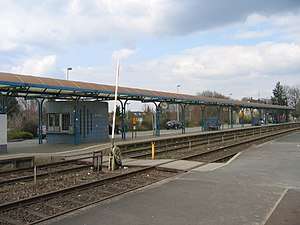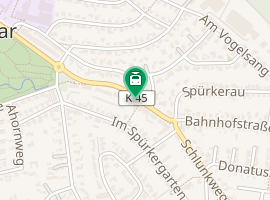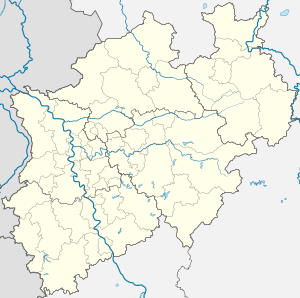Erftstadt station
Erftstadt station is the only passenger station of the town of Erftstadt in the German state of North Rhine-Westphalia and is thus the major transport hub of the town. The station building is located in the district of Liblar. The station is served by Regional-Express services, RE 22 (Eifel Railway) and RE 12 (Eifel-Mosel-Express) and Regionalbahn service RB 24 (Eifelbahn) of the Verkehrsverbund Rhein-Sieg (Rhine-Sieg transport association, VRS), which run from Trier via Kalle to Cologne Hauptbahnhof and together provide services at 30-minute intervals. These services operate on the Eifel Railway (Eifelstrecke).
| Through station | ||||||||||||||||
 | ||||||||||||||||
| Location | Bahnhofstr. 136-146, Erftstadt, North Rhine-Westphalia Germany | |||||||||||||||
| Coordinates | 50°48′26″N 6°49′59″E | |||||||||||||||
| Owned by | Deutsche Bahn | |||||||||||||||
| Operated by | ||||||||||||||||
| Line(s) |
| |||||||||||||||
| Platforms | 2 | |||||||||||||||
| Other information | ||||||||||||||||
| Station code | 1631[1] | |||||||||||||||
| DS100 code | KEST[2] | |||||||||||||||
| Category | 4[1] | |||||||||||||||
| Fare zone | VRS: 2860[3] | |||||||||||||||
| Website | www.bahnhof.de | |||||||||||||||
| History | ||||||||||||||||
| Opened |
| |||||||||||||||
| Previous names | Liblar | |||||||||||||||
| Services | ||||||||||||||||
| ||||||||||||||||

| ||||||||||||||||
| Location | ||||||||||||||||
 Erftstadt Location in North Rhine-Westphalia  Erftstadt Location in Germany  Erftstadt Location in Europe | ||||||||||||||||
Location
The station area is located on the south-eastern edge of the town between the Ville chain of lakes in the east and the town centre of Erftstadt in the west. The station itself is located in the southern part of the Liblar district.
History
In 1874, the Rhenish Railway Company (Rheinische Eisenbahn-Gesellschaft, RhE) began the construction of an elaborate station in a historicist style, which was opened in October 1875 with the name of Liblar.[4] The first Rhenish briquettes were made on 1 March 1877. As a result, Liblar station also developed into a substantial freight yard in subsequent years. The station building was enlarged in 1913. In 1938, Liblar station was expanded to 16 tracks due to the ever growing demand for brown coal. By 1960, the last open-pit mines had been closed and dismantled and the export of brown coal from Liblar had ended.[5] In the following years, Liblar station lost its importance. In 1969, as part of a municipal reform and the reorganisation of the district of Euskirchen, several municipalities (including Liblar) were combined and the city of Erftstadt was founded. In 1981, the old station building was demolished by Deutsche Bundesbahn.[6] The modern station was built in the same location as the original station during the upgrade of the Cologne–Trier railway.[7] The station was renamed Erftstadt on 27 May 1990.[4]
Infrastructure
The station has two platform tracks. In addition, the station has parking, bicycle parking, direct access to the bus stop, a taxi stand and a small kiosk. It is served by three regional rail services together providing two services an hour during working days. Rail services are operated by DB Regio Südwest with diesel railcars of classes 620 and 622 with up to three sets coupled. Currently, however, only a maximum of three two-part or two three-part sets are coupled together.[8][9][10]
| Line | Service | Route | Interval |
|---|---|---|---|
| RE 22 | Eifel-Express | Cologne – Erftstadt – Euskirchen – Gerolstein | 60 minutes |
| RB 24 | Eifelbahn | Cologne – Erftstadt – Euskirchen – Kall | 60 minutes |
The station is also served by four bus routes: 920 (Lechenich – Gymnich – Türnich – Kerpen – Sindorf – Horrem, operated by Regionalverkehr Köln at 30- to 60-minute intervals), 975 (Türnich – Horrem – Bergheim – Bedburg – Kaster, operated by Rhein-Erft-Verkehrsgesellschaftat (REVG) at 60-minute intervals), 977 (Liblar – Türnich – Frechen, operated by REVG at 30- to 60-minute intervals), 990 (Lechenich + Brühl – Wesseling, operated by REVG at 30- to 60-minute intervals).[8]
References
Footnotes
- "Stationspreisliste 2020" [Station price list 2020] (PDF) (in German). DB Station&Service. 4 November 2019. Retrieved 15 November 2019.
- Railway Atlas 2017, p. 202.
- "VRS-Gemeinschaftstarif" (PDF) (in German). Verkehrsverbund Rhein-Sieg. 20 April 2020. p. 200. Retrieved 9 May 2020.
- Joost, André. "Erftstadt station operations". NRW Rail Archive (in German). Retrieved 14 June 2020.
- Bartsch 2012.
- Year Book 2002.
- Klahr 1999, pp. 75–82.
- Joost, André. "Erftstadt station". NRW Rail Archive (in German). Retrieved 14 June 2020.
- Joost, André. "RE22: Eifel-Express". NRW Rail Archive (in German). Retrieved 14 June 2020.
- Joost, André. "RB24: Eifel-Bahn". NRW Rail Archive (in German). Retrieved 14 June 2020.
Sources
- Bartsch, Frank, ed. (2012). Kontinuität und Wandel auf dem Lande, Die rheinische Bürgermeisterei Lechenich im 19. und beginnenden 20. Jahrhundert (1815-1914) (in German). Weilerswist: Verlag Ralf Liebe.
- Klahr, Hans P. (1999). Liblar 1150 – 2000 Das Buch zur Geschichte (in German) (1 ed.). pp. 75–82.
- Eisenbahnatlas Deutschland [German railway atlas]. Schweers + Wall. 2017. ISBN 978-3-89494-146-8.
- Year Book (in German). City of Erftstadt. 2002.